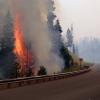 INSTITUTE FOR NATURAL RESOURCES
INSTITUTE FOR NATURAL RESOURCES
The term "watershed" is commonly used to refer to an area in which all surface waters flow to a common point. USGS identifies 92 watersheds in Oregon.

Providing access to information to evaluate large landscapes over time in the West

Wetlands are uniquely productive and valuable ecosystems with permanent or seasonal standing water. Salt marshes, pitcher-plant bogs, mountain fens, and desert saltgrass flats are just a few of the wetland types in Oregon.

Wetlands are uniquely productive and valuable ecosystems with permanent or seasonal standing water. Salt marshes, pitcher-plant bogs, mountain fens, and desert saltgrass flats are just a few of the wetland types in Oregon.

Wetlands are uniquely productive and valuable ecosystems with permanent or seasonal standing water. Salt marshes, pitcher-plant bogs, mountain fens, and desert saltgrass flats are just a few of the wetland types in Oregon.

Wetlands are uniquely productive and valuable ecosystems with permanent or seasonal standing water. Salt marshes, pitcher-plant bogs, mountain fens, and desert saltgrass flats are just a few of the wetland types in Oregon.

The Oregon Wildfire Risk Explorer is designed to identify the wildland-urban interface and wildfire risk at the property ownership level. It shows a comprehensive view of wildfire risk within the State of Oregon, indicates local fire history, and offers additional resources.

Wildlife can be defined as non-domesticated animals and their associated habitats. The Oregon Conservation Strategy offers a blueprint for conservation of the state’s native fish and wildlife and their habitats.

